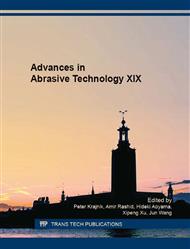[1]
H.K. Tönshoff, W. v. Schmieden, Inasaki I., W. König, G. Spur, Abrasive machining of silicon. Annals of CIRP 39/2 (1990) 621-635.
DOI: 10.1016/s0007-8506(07)62999-0
Google Scholar
[2]
International technology roadmap for semiconductors committee, The international technology roadmap for semiconductors 2011 Edition - Front End Process.
Google Scholar
[3]
G. Byrne, B. Mullany, P. Young, The effect of pad wear on the chemical mechanical polishing of silicon wafers, Annals of CIRP 48/1 (1999) 143-146.
DOI: 10.1016/s0007-8506(07)63151-5
Google Scholar
[4]
Enomoto T., Satake U., Miyake T., Tabata N., A newly developed polishing pad for achieving high surface flatness without edge roll-off, Annals of CIRP 60/1 (2011) 371-374.
DOI: 10.1016/j.cirp.2011.03.125
Google Scholar
[5]
Satake U., Enomoto T., Matsuda K., Improvement of edge surface flatness by a new stacked polishing pad, Procedia CIRP 1 (2012) 704-705.
DOI: 10.1016/j.procir.2012.05.023
Google Scholar
[6]
G.Q. Cai, Y.S. Lu, R. Cai, H.W. Zhang, Analysis on lapping and polishing pressure distribution, Annals of CIRP 47/1 (1997) 235-238.
DOI: 10.1016/s0007-8506(07)62825-x
Google Scholar
[7]
C. Srinivasa-Murthy, D. Wang, S.P. Beaudoin, T. Bibby, K. Holland, T.S. Cle, Stress distribution in chemical mechanical polishing, Thin Solid Films 308-309 (1997) 535-537.
DOI: 10.1016/s0040-6090(97)00433-1
Google Scholar
[8]
J. Tichy, J.A. Levert, L. Shan, S. Danyluk, Contact mechanics and lubrication hydrodynamics of chemical mechanical polishing, J. the Electrochemical Society 146/4 (1999) 1523-1528.
DOI: 10.1149/1.1391798
Google Scholar
[9]
Satake U., Enomoto T., Hirose K., Polishing pad properties for achieving high edge surface flatness, Proc. of the 13th euspen int. conf. (2013) 257-260.
Google Scholar
[10]
Kimura M., Saito Y., Daio H., Yakushiji K., A new method for the precise measurement of wafer roll off of silicon wafer, Japanese Journal of Applied Physics Pt. 1 38/1A (1999) 38-39.
DOI: 10.1143/jjap.38.38
Google Scholar
[11]
Ueshita K., G.G. Meyerhof, Surface displacement of soil-rock systems under uniformly distributed loads, Transactions of the Japan Society of Civil Engineers 143 (1967) 9-15.
DOI: 10.2208/jscej1949.1967.143_9
Google Scholar
[12]
Satake U., Enomoto T., Evaluation of polishing pad property by rubber hardness test - Estimating edge surface flatness of workpiece, Procedia CIRP 14 (2014) 329-332.
DOI: 10.1016/j.procir.2014.03.090
Google Scholar


